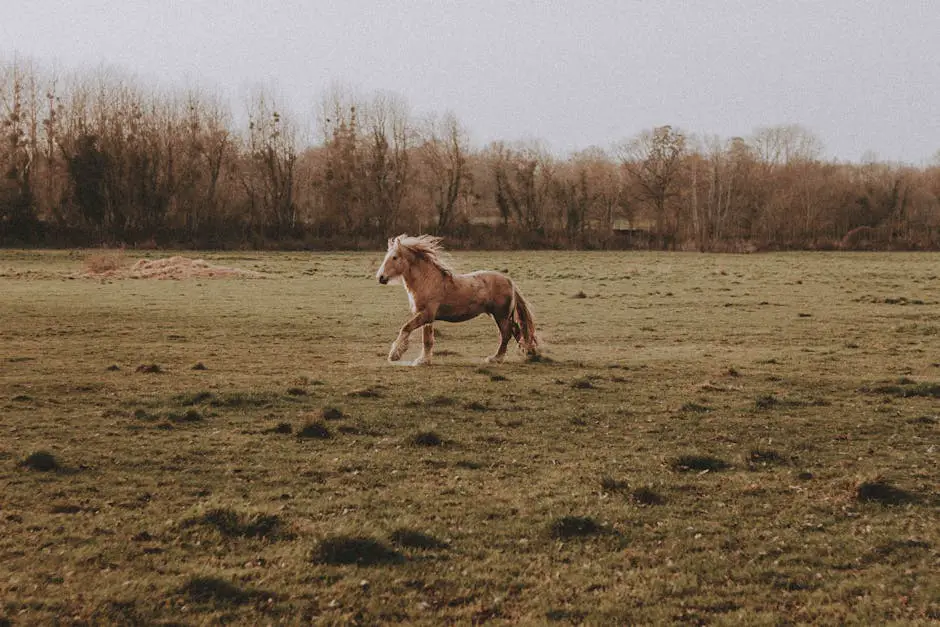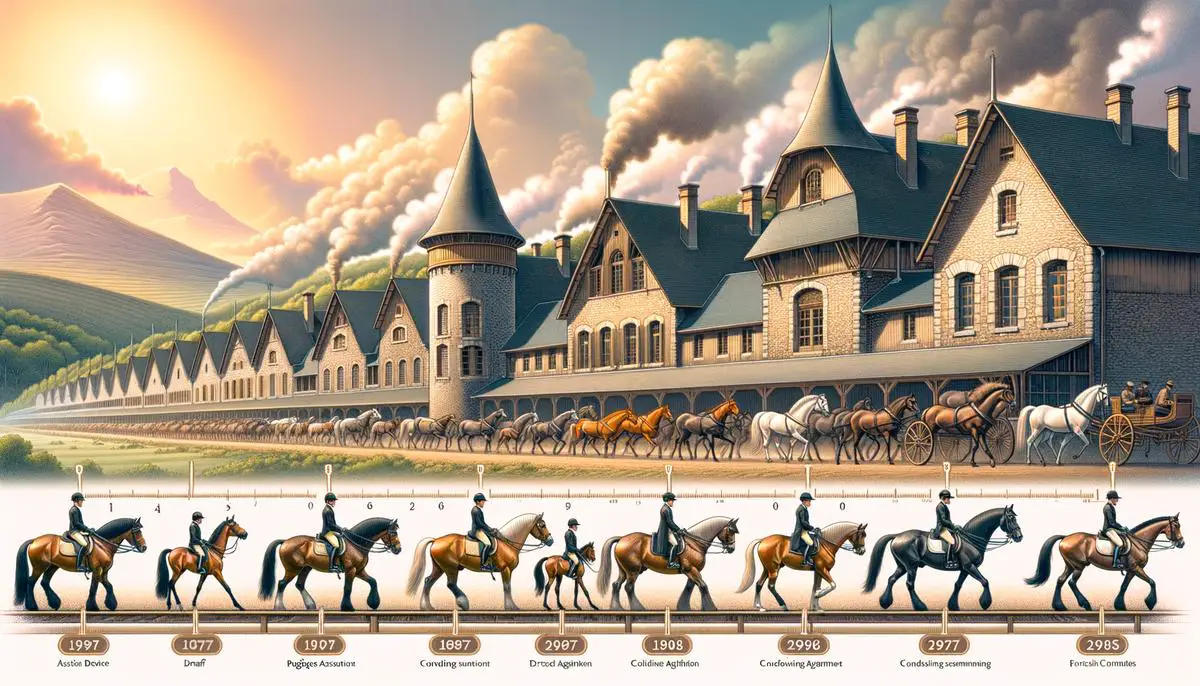Stud farming in France, a practice that intertwines the nation’s passion for horses with its historical and economic fabric, has evolved through centuries to hold a place of prestige in today’s world. This evolution, reflecting significant shifts in societal roles and technological advancements, paints a vivid picture of France’s relationship with equine culture. As we explore the transformation of stud farms from their medieval roots to modern marvels of sustainability and innovation, we uncover the immense value they add, not just to French culture, but to global equestrian practices.
Table of Contents (Horspedia)
History and Evolution of Stud Farms in France
Stud farming, the practice of breeding horses, holds a prestigious spot in French culture and its economy. This journey began in the medieval era, reflecting France’s long-standing passion and respect for equine excellence. Over centuries, French stud farms evolved, intertwining with the nation’s identity and economic development. Let’s gallop through this evolution to understand its significance today.
Historically, horses in France served more than transportation or agricultural roles; they were symbols of power and prestige. Nobility flaunted their wealth and status through the quality of their horses. By the time of the Renaissance, with the consolidation of royal power, the monarchy began to formalize horse breeding. The establishment of royal stud farms, or “Haras Royaux,” under the reign of Louis XIV marked a pivotal moment. These institutions aimed to improve horse breeds not only for military purposes but also to enhance agricultural and transportation efficiencies.
Moving into the 19th and 20th centuries, the advent of industrialization and mechanization began to change the role of horses in French society. However, rather than diminishing the importance of stud farming, these changes shifted its focus. Racing and sport replaced agriculture and war as the primary drivers of equine value. Prestigious races like the Prix de l’Arc de Triomphe, initiated in 1920, and the cultivation of breeds suited for competition, such as the Selle Français, underscored this shift.
Parallel to its cultural significance, stud farming also emerged as an economic linchpin. The global reputation of French breeds and the lure of horse racing have attracted significant international investment. Regions such as Normandy became synonymous with high-quality horse breeding, contributing substantially to local economies through both direct sales and tourism. The economic impact is further amplified by the ancillary industries it supports, from veterinary services to feed production, showcasing the multifaceted value of stud farming to the French economy.
The incorporation of science and technology into breeding practices marks the latest chapter in the evolution of French stud farming. Genetic research, advanced reproductive technologies, and meticulous record-keeping have become standard practices, aiming to enhance breeds not only in terms of physical prowess but also genetic health. This scientific approach underscores France’s commitment to maintaining its leadership in the global equine industry.
The transition of stud farming in France from a medieval necessity to a modern marvel reflects broader historical and cultural trends. It embodies France’s knack for blending tradition with innovation, contributing to the nation’s identity and economic vitality. As it evolved, stud farming cemented its role in the fabric of French culture, becoming much more than just about the horses—it’s a symbol of perseverance, excellence, and elegance.

The Most Renowned French Stud Farms
In exploring what elevates a stud farm to a place of renown, one must peel back the layers to see beyond the champion horses prancing in the fields. It’s a blend of legacy, genetic excellence, and innovative practices. These farms have mastered the art of breeding, not just for physical prowess but for the intangible qualities that make a champion horse.
France, with its rich equine heritage, is home to several top-tier stud farms, each with their own claim to fame. Haras de Fresnay-le-Buffard, for instance, is one such establishment that has risen to prominence. Nestled in the picturesque Normandy countryside, it became the bedrock of success through the meticulous selection of breeding stock, resulting in offspring that have left indelible marks on racetracks around the globe.
Another standout is Haras du Quesnay, equally steeped in history and success. This farm has become synonymous with quality and excellence, tracing its lineage back to some of the most influential thoroughbreds in history. At the heart of Haras du Quesnay’s success is a commitment to not only preserving but enhancing genetic lines, ensuring the legacy of their champions continues.
What truly sets these renowned stud farms apart is an unyielding dedication to every facet of horse care and development. From the choice of mare and stallion pairings to the nurturing environment provided to foals, no detail is too small. Nutrition, veterinary care, and individualized training programs are meticulously planned and executed, ensuring each horse reaches its maximum potential.
Furthermore, these prestigious farms serve as centers for learning and innovation. They employ cutting-edge technology in genetic research, striving to understand the complexities of DNA and how it influences traits such as speed, endurance, and temperament. This scientific approach is balanced with traditional horsemanship, passed down through generations.
In the vast fields of Normandy and beyond, these stud farms do not simply breed horses; they cultivate legends. Haras de Fresnay-le-Buffard, Haras du Quesnay, and others like them stand as pinnacles of excellence, embodying the essence of what makes a stud farm renowned. Through a blend of heritage, science, and unwavering commitment to quality, they continue to sculpt the landscape of horse racing and equestrian sports, not just in France but across the world.

The Business of Breeding: Economics of Stud Farms
Diving into the realm of elite stud farms, the essence of their success lies in a foundational trio: legacy, genetic brilliance, and avant-garde methods. This trifecta doesn’t just distinguish standout farms; it propels them into the echelons of renown, where their impact ripples through the equestrian world and into broader economic spheres.
Take Haras de Fresnay-le-Buffard, for instance. Its climb to the top is not just a tale of fortunate investments but a saga of painstakingly curated breeding stocks. Each selection narrates an adherence to a vision where only the most exceptional genetic material paves the future. The outcomes? Horses that don’t just win races, but that redefine the standards of equestrian excellence.
Similarly, Haras du Quesnay showcases a steadfast commitment to genetic purity and enhancement. Here, the legacy isn’t only preserved; it’s meticulously refined with each passing generation. Their strategy underscores a deeper understanding of how to meld history with science, cultivating lines that not only endure but dominate.
The commitment of renowned stud farms extends well beyond genetic selection; it envelops every aspect of horse care and development. This comprehensive devotion ensures that animals receive an upbringing that is unparalleled, fostering conditions ripe for legends to emerge. From nutrition to training, no stone is left unturned in the quest for perfection.
Innovation also plays a crucial role, particularly in genetic research. Prestigious farms have turned to the forefront of technology, leveraging scientific advancements to refine breeding practices. Yet, this embrace of the new never sidelines the time-honored art of horsemanship. Instead, a harmonious balance is struck, intertwining the precision of science with the intuition of traditional care.
Situated predominantly in Normandy but extending their influence far beyond, these stud farms not only cultivate legends within the racing and equestrian arenas but also significantly shape the landscape. Their operations, deeply rooted in a quest for excellence, not only bolster the local economy through direct employment and tourism but also place France at the heart of global equestrian sports.
In essence, these sanctuaries of equine prowess contribute far more than champions; they forge a legacy that intertwines with the fabric of the French economy, culture, and beyond. Each horse, a testament to centuries of dedication, carries forward a lineage of excellence that directly impacts economic and cultural landscapes, affirming the unparalleled role of these stud farms in a broader context. Through their unwavering dedication to quality, legacy, and innovation, they remain pivotal in maintaining France’s revered stature in the global equestrian domain.

Sustainability and Innovation in Modern Stud Farms
In the rolling hills and lush landscapes of France, stud farms, or “haras,” as they are locally known, represent not only a continuation of age-old traditions but also a forward-thinking approach to horse breeding. These farms are now at the forefront of sustainability and innovation, embodying a balance between environmental stewardship and the pursuit of equestrian excellence.
One might wonder, how exactly are these sanctuaries of equine heritage integrating modern practices into their operations? It begins with a commitment to sustainable land management. Recognizing the importance of preserving their natural habitats, many farms have adopted eco-friendly practices such as organic farming techniques to grow feed and using natural sources of water more efficiently. These methods not only reduce the carbon footprint but also ensure a healthier living environment for the horses.
Renewable energy sources, such as solar panels and wind turbines, are increasingly being used to power the operations. This shift not only aligns with global efforts to combat climate change but also represents a long-term investment in reducing operational costs and dependence on non-renewable energy sources.
Moreover, stud farms are harnessing the power of technology and science in a bid to enhance the breeding process. Advanced genetic testing is now commonplace, allowing for more informed decisions when selecting breeding pairs. This approach not only helps in preserving the genetic health of the breeds but also in enhancing desirable traits, ensuring that the legacy of excellence continues for generations to come.
In terms of veterinary care, the integration of technology has been transformative. From state-of-the-art imaging techniques to minimally invasive surgeries, the well-being of the horses is monitored and maintained with unprecedented precision. This meticulous attention to health and development is a testament to the dedication of these farms to uphold the highest standards of horse care.
Beyond the confines of the farm, there’s an increasing emphasis on education and community engagement. Many stud farms are opening their doors to the public, offering tours and educational programs that highlight the importance of sustainability in equine management. This not only fosters a deeper appreciation for the equestrian tradition but also educates the next generation on the principles of environmental stewardship.
In embracing these innovations, French stud farms are setting new standards in the realm of equine care and breeding. While the majestic landscapes and the timeless beauty of the horses may evoke a sense of continuity with the past, beneath the surface lies a dynamic blend of tradition and modernity. This marriage of the old and the new ensures that the legacy of the French stud farm not only endures but thrives, paving the way for a future where excellence in equestrianism goes hand in hand with a commitment to sustainability and innovation.

The story of French stud farming is not merely about breeding horses; it’s a reflection of France’s ability to blend tradition with progress, ensuring the legacy of equestrian excellence endures through the ages. Today, these farms stand as testaments to a heritage that celebrates both the majestic beauty of horses and the innovative spirits behind their care and breeding. This balance of preserving the past while embracing the future is what makes French stud farms emblematic of a nation’s enduring love affair with horses, reaffirming their significant role in shaping not only France’s identity but also its economic and environmental landscape.

